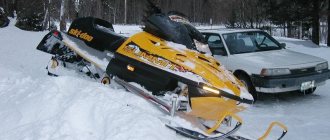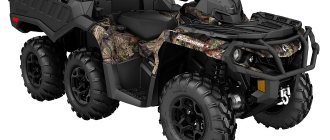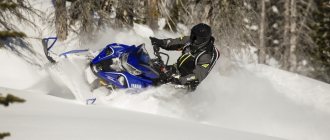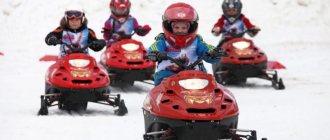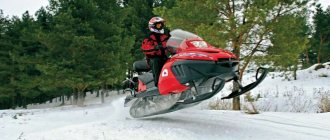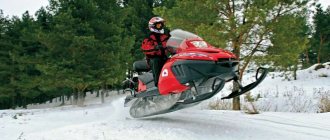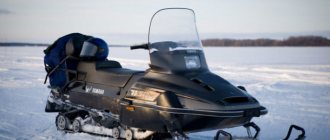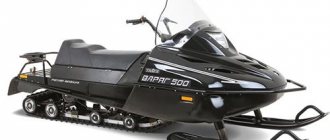000_moto_0112_050
You look at the characteristics of both snowmobiles and you are amazed: the numbers seem to be absolutely identical cars, and the pictures in the advertising brochure clearly hint that the test subjects are, if not twins, but certainly brothers. But as soon as I saw them in person, skepticism about different names for the same car disappeared. The similarities end with the appearance and 800 cc engine. And the fundamental difference is that FreeRide, whose name itself speaks of its career guidance, is built on the basis of the Ski-Doo Summit “mountain bike,” while BoonDocker (which is tempting to be called a chipmunk) uses the Lynx platform. The engines of both are in-line two-stroke “eight hundred” with direct fuel injection, equipped with an electronic reverse system (no gears or gearboxes, just the engine in reverse mode starts in the opposite direction, this is a two-stroke engine!). No “lowering” or electric starters with batteries - everything is subordinated to weight reduction. I was amused by the reverse buttons on both cars: small rubber-coated boxes, attached to the steering wheels with ordinary plastic clamps. On the one hand, it seems to be a “collective farm”, but on the other, you soberly understand that there is simply no need for anything else here. The trend for dual-mode suspension hydraulic adjustments seems to be affecting more than just sportbikes - the FreeRide has separate compression damping adjustments for high and low speed piston rod movement on each shock. I won’t go into detail about the catchiness of the design - you can see for yourself, but I’ll just say that if the “chipmunk” is available only in black, the FreeRide comes in albino form - without any labels, and the owner chooses one of eight color options and glues the snowflake himself.
With a manual starter, even at -32°C, both snowmobiles start quite easily: if warmed up, then with half a turn, and when cold, a maximum of ten times. And what is important, the force on the “rope starter” is adequately small, despite the fact that on the other side of the barricades the compression of two 400 cc “boilers” resists. Direct injection and dosed lubrication systems do their job: the exhaust does not stink of burning, but has a barely noticeable thoroughbred smell, unique only to two-stroke engines.
I started driving around this couple with FreeRide. Colleagues frightened him: they say that he is very harsh, capricious and uncontrollable. But with every meter of virgin snow left behind the toothy caterpillar, I became more and more fused with the car. To say that there is a lot of power is to say nothing. But a two-stroke is a two-stroke - all the thrust is only “from above” and “in the middle”. Matching the character of the engine is the resourceful temperament of the variator - it turns on only after 4500 rpm, which immediately pulls the 154-inch track into the axle box when starting off. The main thing is not to close the gas and not let the car dig in - in a moment FreeRide, like a grasshopper, jumps forward, throwing out a powerful stream of snow from under the caterpillar, and rushes headlong. One hundred, one hundred and forty, one hundred and sixty... The frosty surroundings on the sides of the road begin to blur, and the speedometer needle seems to go crazy. The “claws” of the caterpillar and effective brakes help stop this outrage, because on a two-stroke, closing the throttle does not lead to braking. Yes, this is, of course, not a full-fledged mountain Summit, but you can’t blame it for insufficient cross-country ability. Although the two-stroke engine is sharp, it has a great advantage in weight over four-stroke engines, which is especially important when being rescued from white captivity: it trampled the car, raised its “tail” and rushed on, raising clouds of snow sparkling in the polar sun. After half an hour of driving, the suspensions “thawed out” and began to really work: at any speed and with any irregularities, they smooth out almost all the harshness of the shaking with a bang, and even during landings after jumps they do not break through. It doesn’t seem like a feather bed, and the snowmobile doesn’t gallop like a saiga. The stock positions of the regulators turned out to be quite suitable for my average weight (70 kg). And also about comfort: this seemingly pure sports equipment is not without pleasant little things like adjustable heating and good wind protection. The only thing I would like to improve is that snow constantly accumulates and tramples at the bottom of the footwells, which has to be regularly picked out and pulled out - the standard “drainage” holes instantly become clogged and frozen.
But with controllability, everything is not so clear. I had no reason to doubt either the rigidity of the frame or the correctness of the steering kinematics, but it turned out to be very difficult to check all the reactions of the car. A hefty track and wide skis - inherited features of the Summit family, of course, do not make handling zero, but in order to push the car into a turn along the desired trajectory, you have to work hard. In most cases, especially with an inexperienced rider, the car just goes wherever it wants. Here you have to work hard with your body, loading this or that ski - this is the only way the free ride turns into a “where it needs to be” ride. But as soon as I swapped cars with a colleague, the Free Ride turned out to be much more obedient under the hundredweight of his weight.
To summarize, I can say that the FreeRide is truly a machine for complete breakaway, and on any snow, but it is strictly contraindicated to let dummies near it - the equipment is really very restive.
But who is really mad is the “chipmunk” BoonDocker. What a monster of hell! Although the engine here is the same - the 800th two-stroke from Rotax, in terms of dynamics it beats the FreeRide effortlessly. As soon as you press the gas on the compacted snow, the car actually gets on the track, cutting through the air with skis and rushes forward with wild frenzy. It takes your hands off the steering wheel so much that sometimes it seems as if it’s not a snowmobile, but a sled with a solid fuel accelerator under the seat. The dynamics are at the level of a liter sportbike, the longitudinal overloads are under 1g, too. I've ridden many snowmobiles, but even the BRP MX-Z (what a racing icon it is) doesn't give the same feeling of adrenaline-fueled recklessness as the Chipmunk. The transmission settings match the explosive engine: not a single joule of energy screwed into the variator by the crankshaft is wasted - this can explain the almost constant axle of the track (by the way, it is shorter here than on the FreeRide - 146 inches). BoonDocker itself is much thinner than FreeRide: from the seat cushion to the ski track. Narrow, fast and precise, like a cheetah, I would classify this “chipmunk” not as a rodent, but as a predator. Moreover, the car’s handling is also to match: it writes turning arcs at any speed, as if according to a pattern, at the same time forgiving minor errors in control. Although this is a little strange: since ancient times, Ski-doo family cars have been sharper and more maneuverable than those built on the Lynx platform. The joy of riding a “chipmunk” was overshadowed by the fact that our world is imperfect, because you still have to pay for everything. Even though the track on the Chipmunk is only an inch narrower and eight inches shorter, it does not have as developed lugs as the FreeRide - if you hesitate a little and slow down in deep powder, the car strives to “sit down.” Hence the conclusion is that BoonDocker is a less passable vehicle than its opponent from the Ski-Doo series. This Lynx is more designed for relatively flat and dense snow - there it can fully demonstrate its, without exaggeration, wildest dynamics and refined handling. And as soon as you find a suitable hummock or mound, a mad chipmunk turns into a flying chipmunk - it loses contact with the ground much more readily than a “free” chipmunk. It seems that the shock absorbers on it do not have such a rich set of adjustments, and the cars weigh almost the same, but the fact, as they say, is obvious.
016_moto_0112_050
This seemingly pure sports equipment is not without pleasant little things like adjustable heating and good wind protection.
The only thing I would like to improve is that snow constantly accumulates and tramples at the bottom of the footwells. This seemingly pure sports equipment is not without pleasant little things like adjustable heating and good wind protection. The only thing I would like to improve is that snow constantly accumulates and tramples at the bottom of the footwells.
RESULT. To sum it up, we can confidently call this test a sparring duel without a loser: with the proper skill on a groomed track, the Chipmunk will outshine FreeRide, but as soon as they find themselves on virgin soil, Ski-doo will win back due to cross-country ability with such a margin that no one will not seem small. These are two crowns of engineering, which have one task - to give crazy drive, and each of them does it brilliantly in their own way.
| TECHNICAL SPECIFICATIONS (manufacturer's data) | ||
| COMMON DATA | ||
| Model | BRP Lynx BoonDocker | BRP Ski-doo Summit FreeRide |
| Model year | 2011 | |
| Length × width × height, mm | 3230×1160×1130 | 3335×1140×1130 |
| Weight, kg | 220 | 222 |
| Ski track, mm | 975 | |
| Gas tank volume, l | 39 | 40 |
| Track size, inch | 146*15 | 154*16 |
| ENGINE | ||
| Type | 2-cyl., 2T | |
| Working volume, cm³ | 799 | |
| Max. power, hp at rpm | 155/8500 | |
| Supply system | direct fuel injection | |
| Cooling system | liquid | |
| Starting system | manual starter | |
| TRANSMISSION | ||
| CVT, with engine braking function, electronic reverse | ||
| CHASSIS | ||
| Frame | aluminum, spatial | |
| Front suspension | on two A-arms, ski travel 242 mm | on two A-arms, ski travel 229 mm, compression damping adjustments (fast, slow) and rebound |
| Rear suspension | slick, track travel 390 mm | sliding, track travel 381 mm, compression damping adjustment (fast, slow) and rebound |
| Brake system | disc brake on transmission with hydraulic drive and parking mode | |
The test was organized by ROSAN.
Chasing the Mad Chipmunk: Sports Snowmobiles from BRP
Snowmobiles for deep snow Ski-Doo Freeride
The Freeride series of snowmobiles was created by BRP for extreme riding in deep snow.
The equipment is equipped with powerful engines, suspension specially tuned for deep snow and sports shock absorbers. This is the best choice for adrenaline and thrill seekers. Freeride snowmobiles are built on the lightweight and durable REV Gen4 platform. Its main advantage is the low location of the engine between the skis. Ideal weight distribution and a low center of gravity guarantee precise handling and stability in the most difficult conditions.
Technical characteristics of snowmobiles for deep snow Ski-Doo Freeride
In the 2021 model range, all representatives of the Freeride line are equipped with the best-in-class Rotax 850 E-TEC two-stroke engine. Working in tandem with the pDrive variator, it guarantees an instant response to pressing the gas trigger and excellent dynamics in deep snow. There are two versions to choose from, with track lengths of 154 and 165 inches.
We also note the SHOT launch system. First, the snowmobile starts with a manual starter, after 10 minutes of engine operation, the capacitor accumulates a sufficient charge and subsequently the system uses a magneto to start the engine. To start the snowmobile, just press the SHOT button. In essence, you get an analogue of an electric starter, but at the same time save significant weight.
The RAS 3 linkage suspension is installed at the front. Paired with the Pilot DS 3 skis, it provides excellent performance in deep snow. At the rear is a tMotion suspension designed specifically for mountain snowmobiles. Energy-intensive KYB Pro sports shock absorbers are installed both front and rear. They are great for jumping and tricks.
Other features of Freeride snowmobiles:
- Brembo brakes
- Improved ventilation
- Wide footrests with additional holes
- Compact instrument panel
- Mountain seat
- PowderMax track with flexible sidewalls and high lugs (76 mm)
- 4 liter heated glove box
